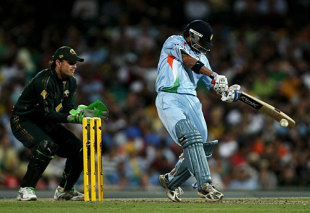India's batting stars fail once again
For the Indians it was a familiar story of top-order failure followed by a late revival
S Rajesh
24-Feb-2008

| ||
After being pushed on to the back foot by the bowlers throughout this tournament, the batsmen at last had something to smile about - the flat pitch, lack of seam movement and the quick outfield were all ideal for run-making, but for the Indians it was a familiar story of top-order failure followed by a late revival.
Gautam Gambhir's polished century and Robin Uthappa's frenetic fifty shouldn't hide the fact that India's best batsmen have been worryingly absent in the CB Series, and the team has lived and died by the performance of the lower middle-order. When they have made significant contributions - as they did against Australia in Melbourne and against Sri Lanka in Adelaide - the team has gone on to win; when they have floundered, as they did against Australia in a low-scoring game in Adelaide, the result has been embarrassing.
In six out of seven matches so far, India have lost their fourth wicket with less than 100 on the board, leaving Mahendra Singh Dhoni and the rest to do much more than their fair share of work. When the squad for the tournament was announced, there was plenty of concern about the lack of experience in the batting line-up, but ironically, it's the most experienced ones who have been letting the team down so far.
Yuvraj Singh played one exceptional innings against Sri Lanka in Melbourne, but that apart, he has scored 42 in five innings, while the opening act of Sachin Tendulkar and Virender Sehwag - both of whom were in smashing form during the Tests - has been even more disappointing: Tendulkar has a highest of 44 from seven innings, while Sehwag has an aggregate of 81 from five. They are the three superstars of the batting order yet they all have an average of less than 20 in the tournament.
Tendulkar has been in fine fettle in both forms of the game over the last couple of years, but just like the fourth innings has been a bit of a jinx for him in Tests, the run-chase has caught him cold in ODIs: over the last three years, Tendulkar averages a mere 26.94 in the 39 matches that India have chased, with 18 single-digit scores. During the same period, he has averaged 56.03 in the 32 innings when India have batted first, with four centuries and just seven scores of less than ten. The last time Tendulkar scored a century in a run-chase was nearly four years ago, when he stroked a glorious 141 in Rawalpindi against Pakistan.
While the pressure of the run-chase hasn't suited Tendulkar, it did little to rein in the flair of Gambhir, who has added consistency to his other virtues to make himself an indispensable member of the batting line-up. He scored fourth-innings hundreds in the semi-final and the final of the Ranji Trophy, and under the lights in Sydney showed once again that he doesn't mind the pressures of a target.
For long Gambhir hasn't been given his due as an ODI player: critics question his technique around off stump and his tendency to open the face of the bat, but the key requisites of one-day cricket are fitness, temperament, and a range of strokes, and Gambhir showed he has all three in abundance.
He came in to bat after India had lost Tendulkar, and they soon slumped to 4 for 51, but not once did Gambhir allow the seemingly hopeless situation to faze him. Equally, he didn't allow himself to get into reckless mode either even though the asking rate was mounting.
| When the squad for the tournament was announced, there was plenty of concern about the lack of experience in the batting line-up, but ironically, it's the most experienced ones who have been letting the team down so far | |||
Throughout, he kept up an impressive tempo, running hard between the wickets to keep the score moving, and improvising superbly to strike the boundaries which kept the required rate within achievable limits. He had shown the same composure in big-match situations during the World Twenty20, and further experience and exposure at the highest level will only increase his consistency.
Uthappa proved his utility at No. 7, and has made a strong case to deserve a promotion up the order. The skills required to combat the new ball, though, are very different to those that are required down the order, and Uthappa's energetic knock will probably tempt Dhoni to keep him at that slot.
After a surprisingly strong start to the tournament, India have fallen away somewhat, with three defeats in their last four games, but thanks to the limp Sri Lankans, they are still the favourites to make the final cut. With the top order floundering like it is, though, Sri Lanka will believe they still have a chance to ensure that they'll have all to play for against Australia next Sunday.
S Rajesh is stats editor of Cricinfo